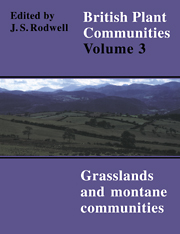Book contents
- Frontmatter
- Contents
- List of Figures
- Preface and Acknowledgements
- Preamble
- Mesotrophic Grasslands
- Community Descriptions
- Calcicolous Grasslands
- Community Descriptions
- Calcifugous Grasslands and Montane Communities
- Community Descriptions
- Index of Synonyms to Grasslands and Montane Communities
- Index of Species in Grasslands and Montane Communities
- Bibliography
MG11 - Festuca Rubra-Agrostis Stolonifera-Potentilla Anserina Grassland
Published online by Cambridge University Press: 04 July 2020
- Frontmatter
- Contents
- List of Figures
- Preface and Acknowledgements
- Preamble
- Mesotrophic Grasslands
- Community Descriptions
- Calcicolous Grasslands
- Community Descriptions
- Calcifugous Grasslands and Montane Communities
- Community Descriptions
- Index of Synonyms to Grasslands and Montane Communities
- Index of Species in Grasslands and Montane Communities
- Bibliography
Summary
Synonymy
Potentilla anserina nodum Adam 1976; Lolio-Agrostetum stoloniferae Page 1980.
Constant species
Agrostis stolonifera, Festuca rubra, Potentilla anserina.
Physiognomy
The Festuca rubra-Agrostis stolonifera-Potentilla anserina community is a somewhat variable vegetation type including generally species-poor, open and closed swards in which A. stolonifera with F. rubra and/or P. anserina are usually the most abundant species. No other grass is frequent throughout, although Poa pratensis (and P. subcaerulea in the north), Holcus lanatus and Elymus repens occur occasionally and each can be abundant. Carex distans, Juncus articulatus and J. gerardi are infrequent but sometimes conspicuous in particular stands.
The cover of P. anserina is very variable and on occasion it may dominate. Other dicotyledons are usually few and only Trifolium repens occurs frequently. Stellaria media, Cirsium arvense, Rumex crispus, Plantago lanceolata, Cerastium fontanum and Ranunculus acris are occasional in generally smaller amounts.
Bryophytes are usually very sparse.
Sub-communities
Lolium perenne sub-community: Lolio-Cynosuretum lotetosum uliginosi Sissingh & Tideman 1960 p.p.; Potentilla anserina nodum Adam 1976 p.p.; Lolio-Agrostetum stoloniferae Page 1980; Potentilla anserina-Poa trivialis community Birse 1980. In the generally closed swards of this sub-community, L. perenne is often codominant with A. stolonifera with varying amounts of F. rubra and P. anserina. Other grasses are rather more prominent here than in the other sub-communities with H. lanatus, Festucapratensis, Dactylis glomerata, Agrostis capillaris and Phleumpratense ssp. pratense preferential and often producing large amounts of succulent herbage. Trifolium repens, Ranunculus repens, Taraxacum officinale agg., Cerastium fontanum and Cirsium arvense are the most frequent dicotyledons and Rumex obtusifolius partially replaces R. crispus, being especially conspicuous on poached areas. In salt-marsh stands, there are occasional records for Juncus gerardi, Triglochin maritima, Carex distans, Glaux maritima, Atriplex prostrata, Matricaria maritima and Oenanthe lachenalii. Stellaria media and Urtica dioica sometimes become prominent in patches, the latter being especially conspicuous in small dense stands up to 50 cm tall. Bryophytes are somewhat more frequent in this sub-community and, especially on bare damp areas in winter, Eurhynchium praelongum may be abundant.
Atriplex prostrata sub-community: Stellaria media saltmarsh McVean 1961; Potentilla anserina nodum Adam 1976p.p. Here, A. stolonifera and P. anserina are generally co-dominant with usually smaller amounts of F. rubra. Apart from Elymus repens and Poa pratensis, both of which can be abundant, other grasses, including L. perenne, are rare.
- Type
- Chapter
- Information
- British Plant Communities , pp. 94 - 98Publisher: Cambridge University PressPrint publication year: 1992



